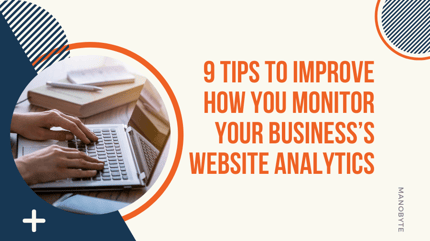
You’ve got your website up and running, with great images, compelling copy, great marketing content and the latest bells and whistles.
So how do you know if it’s working?
Utilize these nine tips to best monitor website analytics.
Nine Tips to Best Track Website Analytics
While having a website is all well and good, understanding the data around your website – your visitors, your pages, your traffic sources and your reach – will make your site better and generate more revenue.
Check out these nine tips to better monitor your website analytics.
Tip #1. Know What Analytics You Are Tracking
There is a ton of data to collect and look at regarding your website. Which data are the most essential for you to track? Here are some suggestions:
Traffic Volume
How many visitors are you attracting year over year and month over month? Date ranges help you account for seasonal variations or track efficacy of inbound marketing strategies
New Vs. Returning Traffic
Repeat business is important, but so too is providing more leads. Looking at this metric is a way to focus on what marketing is working and how to attract repeat customers
Traffic Channels
Knowing what channels visitors used to access your website is a good way to understand what gets people “in the door” virtually. Traffic channels that Google Analytics uses include:
Direct traffic
Those who type in your URL to a browser
Display
From a paid ad
Traffic from emails (note that you need to put tracking parameters in your emails)
Organic search
Visitors from search engine queries
Referrals
Traffic from other websites or third-party referrals
Social
Traffic from various social media platforms
Tip #2. What Is the Buyer Persona?
You have a website because you want to convert visitors into buyers. Your website is an important part of the journey buyers take.
Use your analytics to construct buyer personas that indicate what steps buyers take and when. That means looking at when buyers ask for more information or sign up for a company newsletter.
Look at what pages buyers visit first and last before making a sale and fine-tune the content on those pages. Also make sure to adjust your marketing to direct people to those pages that result in the most conversions.
Tip #3. Learn What Content Types Visitors Consume
Do you have videos embedded on your site? Requests for more information? Signups for newsletters or white papers? Looking at these content numbers can help you to understand what types of content you should be providing on your site and in what format.
As with many of the tips listed here, there are interrelationships. For example, knowing that visitors who look at video content are more likely to become buyers can lead you to add more video content and rethink your buyer persona.
Tip #4. Embrace Bounce Rates
Not every visitor to your website will end up a customer. You will have many visitors who stay for short periods of time. Mapping out where people abandon your site provides great insights. You’ll learn where people are bailing. Pay particular attention to the bounce rates on your home page; if visitors are leaving without going elsewhere you have a fundamental issue with the main site.
Tip #5. Know Your Website Speed
The faster your website loads, the better off you are. Monitoring your website speed lets you see if there are components of your pages that are slow to load and may need to be changed, modified or removed.
You want your pages to load in 3 seconds or fewer in order to not contribute to higher bounce rates. Load times can also affect your search engine optimization rankings, so fixing what’s slowing down pages is important.
Tip #6. Click Rates
What items on your pages generate the most clicks? What doesn’t get any reaction from visitors? Click-through rates are important for more than blog posts and videos.
For example, knowing which social media icons get the most responses can lead you to a more refined focus on certain channels. What sections of your main navigation section get the most response? What do these data tell you?
Tip #7. Know the Devices Visitors Are Using
Analytics lets you understand better the devices from which users connect to your pages. While it’s assumed today that brands build mobile-first websites, your results may vary. So knowing the percentages of visitors on smartphones, desktops, laptops and tablets gives you a clearer understanding of how people are connecting.
Tip #8. Know What You’ll Be Using It For
Different website analytics give you insights on different parts of your business. Knowing what you want to learn can help determine which website analytics to look at. There are different considerations if you’re looking to know which content visitors consume, the efficacy of an online form, the results of a social media campaign or which landing pages are driving the most sales.
Tip #9. Act On What You Learn
Monitoring website analytics will give you actionable insights. Be sure to take what you learn and make adjustments to your website, to your marketing, to your inventory or to your messaging. These insights are an excellent opportunity to improve operations and gain more sales.
At ManoByte, we offer extensive website services, including user experience testing, design, search optimization and platform integration. To learn more about our website and marketing services, contact us today.
Ready to Dive In?
Work with our team of Business Process experts and watch us take manual clunky systems, tech stacks, and processes and turn them into tailored, intelligent workflows that deliver business outcomes.


